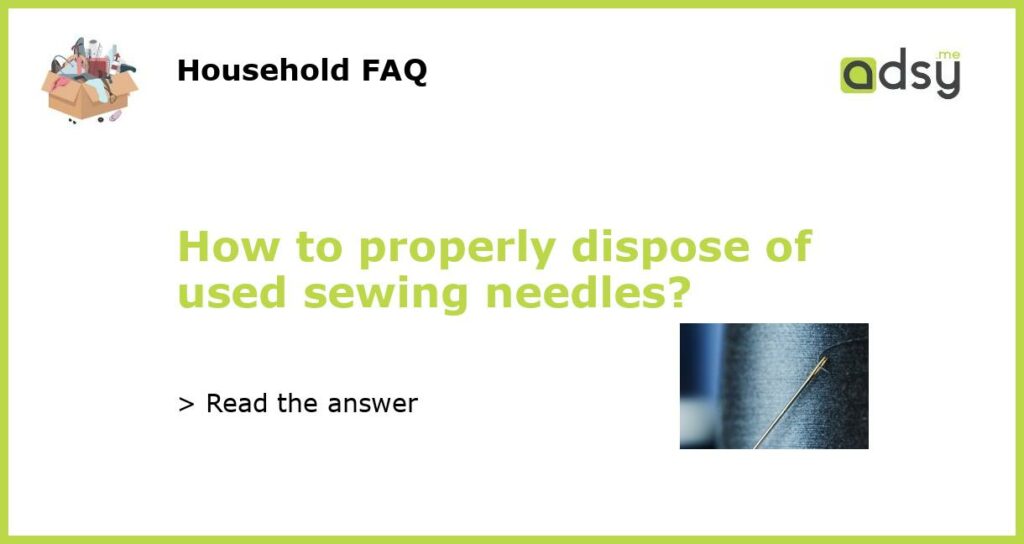Understanding the importance of proper needle disposal
Proper needle disposal is crucial for various reasons. Firstly, used sewing needles pose a significant risk to public health and safety if not disposed of properly. Poor disposal practices can lead to accidental injuries, especially for waste handlers. Moreover, improperly disposed needles can end up in recycling or landfill facilities, where they can potentially injure workers or damage equipment. Secondly, responsible needle disposal is necessary to prevent the spread of diseases. Used needles can carry bloodborne pathogens, such as HIV or hepatitis, which can be transmitted if someone comes into contact with a discarded needle. Finally, disposing of needles in an appropriate manner demonstrates environmental consciousness and ensures our communities remain clean and safe.
Safe and proper needle disposal methods
When it comes to disposing of used sewing needles, there are a few standard methods that guarantee safe handling and prevent accidental injuries:
- Use a sharps container: A sharps container is specifically designed to safely hold and contain needles. These containers are puncture-resistant and sealable, preventing accidental pricks or exposure to bloodborne pathogens. Once full, the sharps container should be sealed tightly and placed in a designated disposal bin or returned to a pharmaceutical or medical waste facility. Some local municipalities offer free sharps container exchange programs, so it’s worth checking whether such services are available in your area.
- Create a DIY sharps container: If a commercial sharps container is not readily available, you can make a temporary one using a puncture-resistant container, such as a thick plastic detergent bottle or a coffee can. Ensure the container has a tight-fitting lid and label it clearly as containing sharps. Once full, securely tape the lid shut and dispose of it using a local needle exchange or pharmaceutical waste disposal service.
Do’s and don’ts of needle disposal
When it comes to needle disposal, it’s important to follow a few essential do’s and don’ts:
- Do label your sharps container: Whether you’re using a commercial sharps container or a homemade one, make sure to label it clearly as containing sharps. This will alert waste handlers and ensure proper handling and disposal.
- Do not place loose needles in the regular trash: Throwing loose needles in the garbage poses a risk to waste handlers and is against proper disposal practices. Always use a designated sharps container for needle disposal.
- Do not recycle needles: Recycling facilities are not equipped to handle sharp objects like needles. Never place used needles in recycling bins, as this can endanger workers and contaminate recyclable materials.
- Do not flush needles down the toilet: Flushing needles down the toilet is not only an unsafe disposal method but also poses a risk to wastewater treatment systems and the environment. Needles can end up in water bodies, posing dangers to people, wildlife, and marine life.
Disposal options for specific locations
While the aforementioned methods are generally applicable, it’s essential to consider specific disposal options based on your location:
- Households: Many local municipalities provide collection programs for household hazardous waste, including used needles. Check with your local waste management department or public health agency to find out if such programs exist in your area. Alternatively, you may be able to drop off your sharps container at a local pharmacy or a designated collection site.
- Medical facilities: Medical facilities, such as hospitals, clinics, and doctor’s offices, generally have procedures and guidelines for the proper disposal of medical waste, including needles. These facilities often partner with waste management companies to ensure safe disposal. It’s imperative for medical professionals to familiarize themselves with their organization’s procedures and follow them diligently.
- Pharmacies: Some pharmacies offer needle disposal services, where you can bring your sealed sharps container for safe disposal. They may also provide information on local collection programs or alternative disposal options.
Educating and spreading awareness
Proper needle disposal goes beyond individual responsibility. Educating others and spreading awareness about safe disposal practices is crucial to creating a safer community. Consider the following ways to contribute:
- Talk to friends and family: Start by discussing the importance of proper needle disposal with your friends and family members who sew. Share the information you’ve learned, including readily available resources for safe disposal.
- Support local initiatives: Get involved with local initiatives or organizations that promote safe needle disposal. Volunteer your time, donate supplies, or help with awareness campaigns.
- Share information online: Take advantage of social media platforms to spread awareness about proper needle disposal. Share educational resources or create posts that highlight the importance of responsible disposal. Remember to include relevant hashtags to reach a wider audience.






